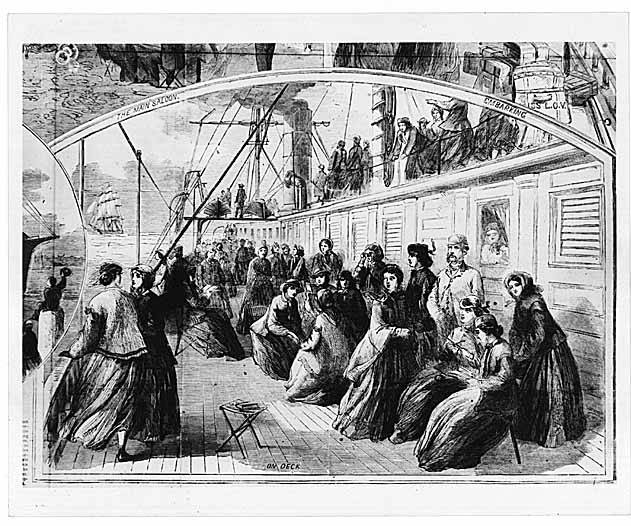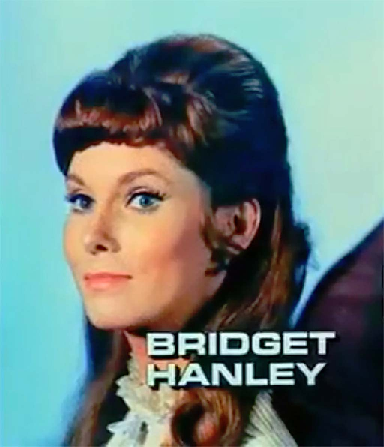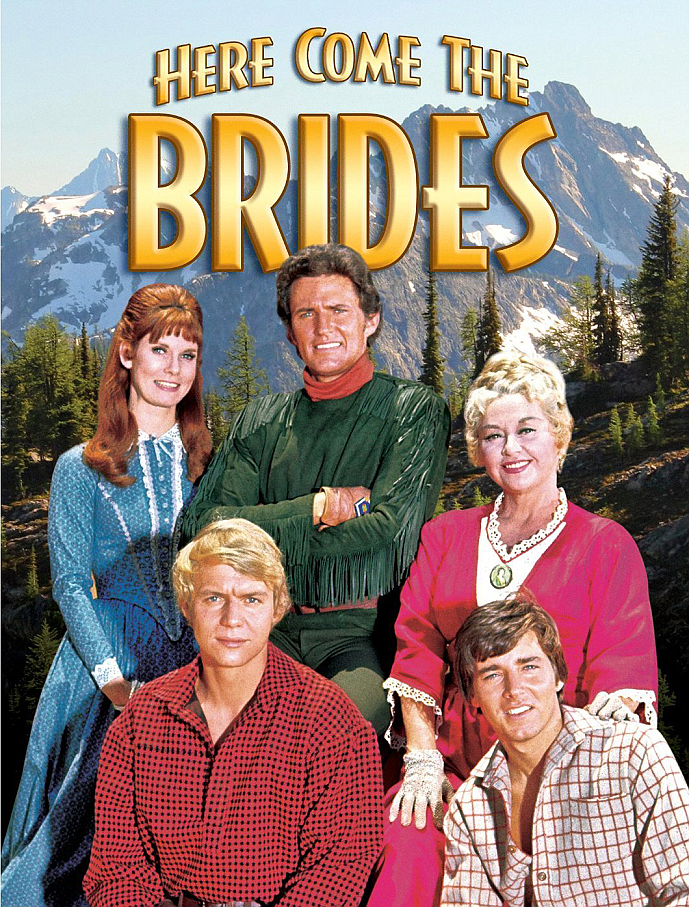'Here Come the Brides' debuts on September 25, 1968
September 21, 2023 at 10:57 a.m.
On September 25, 1968, Here Come the Brides debuts on ABC-TV. The show, loosely based on the arrival in frontier Seattle of the Mercer Girls -- recruited to the new settlement as teachers and to increase the number of marriageable women -- is a light comedy-western that proves popular with viewers, especially those in the Pacific Northwest. One of the show's stars, Bridget Hanley, grew up in Edmonds in Snohomish County north of Seattle. Although the show is well-received during its first season, a reformat and schedule change for the second season causes ratings to drop, which leads to its cancelation.
The Mercer Girls
 Bridget Hanley as Candy Pruitt (front) played one of "The Mercer Girls" in Here Come the Brides
Bridget Hanley as Candy Pruitt (front) played one of "The Mercer Girls" in Here Come the Brides
Screen Gems began as an animation firm in the 1930s, but by the 1960s the studio was heavily involved in television production, mostly with sitcoms. Because of the popularity of shows like Gunsmoke, Screen Gems was looking to develop a western series of its own, but with elements of comedy mixed in, similar to another hit western, Bonanza. In 1967, the studio assigned producer Bob Claver (1928-2017) to create a series based on Seattle's Mercer Girls.
In 1864, Seattle pioneer Asa Mercer (1839-1917) gave a speech in Massachusetts extolling the virtues of Seattle and saying that the fast-growing city needed educated single women of good moral standing to work as teachers. Eleven women decided to take him up on his offer, and a few months later, after a long and arduous voyage that included train passage across the Panama isthmus, the first contingent of Mercer Girls arrived by boat on Elliott Bay.
 An illustration depicting the Mercer Girls from Harper's Weekly, January 6, 1866
An illustration depicting the Mercer Girls from Harper's Weekly, January 6, 1866
The women had an instant impact on Seattle's mostly male frontier culture. Two years later, Mercer organized a second expedition, which brought 34 more unmarried women to Puget Sound. Some of the Mercer Girls stayed to teach in Seattle, while others sought out schoolrooms in Centralia and beyond. Most of the women eventually married -- one wife became the assistant lighthouse keeper at Admiralty Head on Whidbey Island -- and more than a few Puget Sound families can trace their roots to these adventurous women who took a chance and moved west.
Fact into Fiction
The new show, Here Come the Brides, used the Mercer Girls as its basis, but much was changed to bring the story to television. Instead of Asa Mercer, the person who brought the brides west was Jason Bolt, a fictional character who ran a lumber mill with his two younger brothers, Jeremy and Joshua. Instead of a few dozen potential brides, 100 women traveled west, and strong-willed Candy Pruitt (another fictional character) became their de facto leader. The time period was also changed from the 1860s to the 1890s. The show did still take place in frontier Seattle, although it was filmed at the Columbia Ranch in Burbank, California.
 Here Come the Brides cast (clockwise from left) Bobby Sherman, Bridget Hanley, David Soul, Robert Brown, and Joan Blondell, 1968
Here Come the Brides cast (clockwise from left) Bobby Sherman, Bridget Hanley, David Soul, Robert Brown, and Joan Blondell, 1968
Robert Brown (b. 1926) was cast as Jason Bolt, and the two younger Bolts were played by Bobby Sherman (b. 1943) and David Soul (b. 1943). Bridget Hanley, who grew up in Edmonds, played Candy Pruitt, a role that she fought hard to secure. Mark Lenard (1924-1996), who would later go on to fame by playing Spock's father, Sarek, in the Star Trek franchise, was hired to play sawmill owner Aaron Stempel.
 One of the stars, Bridget Hanley, was a local girl who grew up in Edmonds
One of the stars, Bridget Hanley, was a local girl who grew up in Edmonds
Rounding out the main cast was veteran screen actress Joan Blondell (1906-1979), who played saloon owner Lottie Hatfield, who takes the brides under her wing. While the show was being developed, Blondell's character was named Mama Damnation. This may have been a slight nod to Seattle's Mother Damnable -- real name Mary Ann Conklin (1821–1873) -- the city's first hotelier, who was known for her sharp tongue and hot temper. By the time the pilot had been written -- by playwright N. Richard Nash (1913-2000) -- Blondell's character had been softened somewhat and given a more television-friendly name.
Rave Reviews
After the show first aired on September 25, 1969, it garnered rave reviews from publications such as Variety and TV Guide. The show received solid ratings, and was especially popular with young girls, who swooned over teen idol Bobby Sherman. Families also enjoyed the show, which tackled many social issues, such as ethnic discrimination, women's rights, and economic hardship.
The show was a huge hit in Seattle and the Pacific Northwest, an area that rarely had any screen presence on television shows at the time. Seattleites in particular loved the theme song, even more so when lyrics were added to it midway through the first season. "Seattle" -- which began with "The bluest skies you've ever seen are in Seattle" -- later went on to become a hit song for Perry Como (1912-2001), who recorded his version of it in 1969.
Seattleites were also proud that Bridget Hanley, a local actress, was one of the show's stars, and near the end of the first season they got another pleasant surprise. In the episode "Marriage: Chinese Style," Bruce Lee (1940-1973) -- who had gone to high school and college in Seattle -- played a Chinese immigrant. At the time, Lee was best known for playing Kato on The Green Hornet but would soon become famous for his martial arts films before his untimely death in 1973.
 Bruce Lee (left) made an appearance in Here Come the Brides
Bruce Lee (left) made an appearance in Here Come the Brides The Final Frontier
The ratings for the first season of Here Come the Brides were so good that ABC renewed it for a second season. But the network made some changes to the format -- wanting to the show to have more action, and scaling back the comedy -- that did not go over well with the audience. The real stake in the show's heart came when ABC moved its broadcast time from 7:30 on Wednesday night to 9 p.m. on Friday, then considered a graveyard for television shows.
Its ratings fell, and by the end of the season the show was canceled. KOMO-TV, the local affiliate that aired the show, received so many angry phone calls that the station broadcast reruns of the series, even though the show did not initially make it into syndication. It wasn't until many years later that Here Come the Brides showed up on cable, VHS, and DVD.
Oddly enough, long after Here Come the Brides left the screen, another Star Trek connection was made, making the show and its characters a small, but significant, part of the Star Trek universe. In 1985, the Star Trek novel, Ishmael, was published, written by Barbara Hambly. In it, Spock travels back in time to Seattle where, after losing his memory, he ends up being cared for by Aaron Stempel. Spock's presence sets in motion a romance between Stempel and one of the "brides," who later marry. Back in the future, Spock discovers that the Stempels are, in fact, his great-great-great-grandparents.
This essay made possible by the Snohomish County Community Heritage Program
Sources:
HistoryLink.org Online Encyclopedia of Washington State History, "Mercer Girls" (by Peri Muhich), http://www.historylink.org (accessed November 1, 2018); "Pioneer Seattle Gets TV Treatment," The Seattle Times, March 1, 1968, p. 25; "Much Anticipation for 'The Brides'," Ibid., September 8, 1968, p. TV-30; "Notes and Quotes from the Wasteland," Ibid., October 8, 1968, p. 22; "Here They Are Seattle," Ibid., April 10, 1969, p. A-1; Mark Rahner, "The TV Series 'Here Come the Brides' Put Seattle on the Pop Culture Map," Ibid., May 16, 2006, p. E-1; "Bridget Hanley -- Always a Bride," Ibid., June 11, 2006, p. A-8; Bridget Hanley's Official Website accessed September 7, 2018, via Internet Archive (https://web.archive.org/web/20070121181341/http://www.bridgethanley.net:80/index.htm); Lord Gangway, The Here Comes the Brides Book (Albany, GA: Bear Manor Media, 2009); Barbara Hambly, Ishmael (New York: Pocket Books, 1985); "Bridget Hanley," Internet Movie Database website accessed October 8, 2018 (https://www.imdb.com/name/nm0360063/).
Note: This entry replaces an earlier entry on the same subject.





